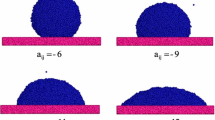Abstract.
We present a mesoscopic model for simulating the dynamics of a non-volatile liquid on a solid substrate. The wetting properties of the solid can be tuned from complete wetting to total non-wetting. This model opens the way to study the dynamics of drops and liquid thin films at mesoscopic length scales of the order of the nanometer. As particular applications, we analyze the kinetics of spreading of a liquid drop wetting a solid substrate and the dewetting of a liquid film on a hydrophobic substrate. In all these cases, very good agreement is found between simulations and theoretical predictions.
Similar content being viewed by others
References
P.G. De Gennes, F. Brochard-Wyart, D. Quéré, Capillary and Wetting Phenomena: Drops, Bubbles, Pearls, Waves (Springer, New York, 2003).
A. Oron, H. Davis, S.G. Bankoff, Rev. Mod. Phys. 69, 931 (1997).
A. Milchev, A. Milchev, K. Binder, Comput. Phys. Commun. 146, 38 (2002).
J. Koplik, J.R. Banavar, Phys. Rev. Lett. 84, 19 (2000).
J. Leopoldes, A. Dupuis, D. Bucknall, J.M. Yeomans, Langmuir 19, 9818 (2003).
B. Davidovitch, E. Moro, H.A. Stone, Phys. Rev. Lett. 95, 244505 (2005).
K. Mecke, M. Rauscher, J. Phys. Condens. Matter 17, S3515 (2005)
R.D. Groot, P.B. Warren, J. Chem. Phys. 107, 11 (1997).
C.P. Lowe, Europhys. Lett. 47, 145 (1999).
P. Español, M. Revenga, Phys. Rev. E 67, 026705 (2003).
A.A. Louis, J. Phys. Condens. Matter 14, 9187 (2002).
I. Pagonabarraga, D. Frenkel, J. Chem. Phys. 115, 5015 (2001).
Even if the $u_{\ab{ex}}$ is not pair-wise additive, it is still possible to express particle interactions in terms of pair-wise forces $\mathbf{F}_{ij}^{\ab{C}}=-(u'_{\ab{ex}}(n_i)+u'_{\ab{ex}}(n_j)) w'_{\rho}(r_{ij}) \mathbf{e}_{ij}$. These forces depend on the positions of all neighbouring particles. Hence, they neither derive from a pair-wise additive potential as in standard DPD nor reduce to global density-dependent forces.
In the simulations the local density is built using the weight function $w_{\rho}(r)=\frac{315}{64 \pi}(1-r/r_{\ab{c}})^{3/2}$ if $r < r_{\ab{c}}$ and zero otherwise. Such a choice is made to favor a smoother local structure (S. Merabia, I. Pagonabarraga, in preparation) and differs from the standard quadratic weight function appearing in the DPD friction force.
Density oscillations at liquid/vapor interfaces have been reported in a variety of fluid models, and are attributed usually to the presence of a Fisher-Widom line (see, e.g., P. Tarazona, E. Chacon, M. Reinaldo-Falagan, E. Velasco, J. Chem. Phys. 117, 3941 (2002)).
S.Y. Trofimov, E.L.F. Nies, M.A.J. Michels, J. Chem. Phys. 117, 9383 (2002).
P.B. Warren, Phys. Rev. E 68, 066702 (2003).
M. Revenga, I. Zuñiga, P. Español, I. Pagonabarraga, Int. J. Mod. Phys. C 9, 1319 (1998).
For simplicity, we use in this work $w_{\ab{c}}(r)=(1-r/r_{\ab{c}})^{1/2}$ for $r<r_{\ab{c}}$ ($w_{\ab{c}}(r)=0$ otherwise).
W.H. Press, B.P. Flannery, S.A. Teukolsky, Numerical Recipes in C, The Art of Scientific Computing (Cambridge University Press, 1992).
If we assume that the line tension can be approximated as the surface tension associated to the interfacial width (see, e.g., S. Auer, D. Frenkel, Phys. Rev. Lett. 91, 015703 (2003)), the line and surface tensions contributions to the free energy become comparable when the area of the contact line is of the order of the contact area, consistent with simulation results.
L.H. Tanner, J. Phys. D 12, 1473 (1979).
Other forms of the fluid/wall net interaction (such as a density-dependent force) may lead to non-monotonous interfacial free energies and to the existence of a thin-film layer in coexistence with the drop.
F. Brochard-Wyart, J.M. di Meglio, D. Quéré, C. R. Acad. Sci. (Paris) 304, 553 (1987).
A. Malevanets, R. Kapral, J. Chem. Phys. 112, 7260 (2000).
Author information
Authors and Affiliations
Corresponding author
Rights and permissions
About this article
Cite this article
Merabia, S., Pagonabarraga, I. A mesoscopic model for (de)wetting. Eur. Phys. J. E 20, 209–214 (2006). https://doi.org/10.1140/epje/i2005-10128-1
Received:
Accepted:
Published:
Issue Date:
DOI: https://doi.org/10.1140/epje/i2005-10128-1




